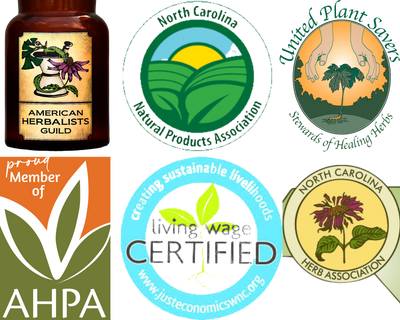Fall and early winter around here at the Red Moon Herbs production and educational gardens is all about roots. The early autumn to pre-winter-solstice season has us processing roots like echinacea like crazy. Digging, dividing, transplanting, washing, chopping, and infusing echinacea roots is knees-dirty, full-on, hands-full and hearts-full work.
Rising tall in the summer meadow with her characteristically spiky nests of seedheads following a showy floral display, purple coneflower or echinacea has a striking appearance of royalty: a queen among the plant kingdom. But come the fall and winter of her third year of growth, her royal roots below are dense and gnarly, matted, thick and dark and otherworldly.
Echinacea Extract 101
Allying with
echinacea extract during the fall and winter seasons makes all the difference between a two-week-long battle with the aches, discomforts, and sniffles and perhaps a day-long bout of the immune system rising to a particular challenge. This herb can be compared to a first responder of the plant world - strong, reliable, adaptable, and equipped to jump in and save the day at a moment's notice. A dependable friend, echinacea is well-suited to a protocol of foundational herbal support to keep you well during any time of the year.
How Does Echinacea Work?
Echinacea uniquely offers support to the immune system over both the long term and the short term. Useful as a long-term herb for supporting chronic conditions, echinacea can be taken daily as part of an overall herbal regimen. As an acute ally in the moment of immune deficiency, large doses of echinacea are useful to provide speedy support. Many report experiencing noticeable benefit within a matter of hours. In combination with restful sleep, deep nutritional nourishment, and herbs that synergize well - think extracts like astragalus, elderberry, the beneficial mushrooms, and usnea - echinacea can turn a rundown day right around.
Echinacea has a reputation for improving the efficacy of white blood cells rapidly. It is known for acting to support issues of both bacterial and viral origins. One of the many chemical constituents that it contains, polysaccharides, are long chains of plant-powered sugars responsible for echinacea’s ability to modulate the immune system.
The mechanism of action of this herb is complex but is said to involve phagocytosis - the process of cells eating bacteria and other particles - being activated, respiratory activity heightening, and white blood cell mobility increasing.
Those with a common cold who take echinacea may experience increased white blood cell activity along with increased sensations of health and vitality, which is exactly what we want when dealing with a viral or bacterial “bug”. Individuals who take echinacea may experience a reduction in their experience of discomfort and an overall decrease in their number of days of illness.
Topically, echinacea is highly supportive of skin health especially when dealing with inflammation and various skin conditions. Fresh echinacea ointment may be beneficial to those who use it to support their inflammatory skin issue.
Herbal synergy - working together to improve the beneficial pathways of each - is an important force. Combinations like our Immune Blend formula combines three abundant, potent, and well-researched herbs to optimally support the body's immune system to be its own best advocate. Usnea, echinacea, and elderberry are a wham bam trio for health and wellness, and round out any potential drying, cooling energy that echinacea might have on its own.
What’s in Your Echinacea?
Echinacea should only be used from a trusted source of the organically cultivated, carefully prepared plant. Unfortunately, echinacea’s gain in popularity has meant that many of the echinacea products that are mass-marketed to consumers are adulterated with additives, fillers, and other dubious ingredients, or - even worse - contain no echinacea at all. Consumer Lab examined the contents of nearly a dozen echinacea products from various companies only to find that, of the brands investigated, only one-third of them actually contained echinacea herb. Considering this horrifying reality, herb-takers everywhere have every right and responsibility to be picky and choosy when it comes to selecting an echinacea product.
Other considerations are important beyond ensuring that your echinacea is what it says it is. As with many herbs, when it comes to potency, fresh or freshly dried is best. Dried roots or flowers of echinacea can be used for making herbal preparations, but they may be noticeably less strong tasting that the real deal: freshly dug and hand-chopped echinacea roots immediately extracted into a bioavailable menstruum. The signature tingle of echinacea is indeed a sign of its efficacy; the more sharp and biting of a sensation it produces on or under the tongue, the stronger the potency is.
What to Look for in Your Echinacea
Consider this your cheat sheet to echinacea choices - the most important qualities to look for are:
- Freshness and plant part used - fresh rather than dry echinacea herb is generally preferable when available. The root is preferable as the most potent part of the plant, though the flowering heads may also be used.
- Conscious cultivation - wild echinacea is less and less common as its natural growing environment has been depleted across the country and its popularity has grown. Sadly, United Plant Savers lists Echinacea spp. as an at-risk plant based on the vulnerability and devastation of its home habitats. Look for echinacea that is organically cultivated by small-scale farmers for the absolute best quality.
- Potency - look for echinacea products that contain echinacea and only echinacea, extracted in a medium that is organic and able to be easily absorbed by the body, such as organic cane alcohol.
There are many schools of thought when it comes to what species of echinacea is best. After much consideration, we choose to use both Echinacea angustifolia and Echinacea purpurea in our echinacea extract for reasons concerning both sustainability and strength.
How Much Echinacea Should You Take?
Echinacea is most supportive when taken in a dose appropriate for one’s specific body weight. See (and save) this handy chart for an approximate dosing suggestion. With this particular herb, we find that the more often it is taken - especially in the very beginning stages of feeling rundown - the more the body has the chance to benefit from it. Whenever I start to feel a throat tickle, the first thing I do is reach for the trusty tingle of echinacea as my line of first defense. Remember, though, that with echinacea, more is more: the best echinacea dosage may be higher than you think to achieve its most potent effect.

Check out (and save) this graphic as a good rule of thumb. Our totally tingly echinacea extract will be at its best and most potent when used according to these guidelines. Echinacea is helpful for use during pregnancy and can be taken at many ages and stages of life. Those with autoimmune conditions or anyone immuno-compromised should consult a qualified practitioner before incorporating echinacea into a daily protocol. Echinacea can also be used with some pets (use caution with cats, however), and may help your family dog with whatever viral or bacterial challenge they might be facing. Note that echinacea is in the aster family, so those with allergies to plants in this family, use extra caution.
Echinacea for Extra Oomph
Allying with echinacea all year round is a win-win for the immune system both acutely and on an ongoing basis. Choosy herbal consumers who are mindful of ethical harvesting standards will do well to select a quality echinacea preparation that is organically cultivated from a source with integrity.














